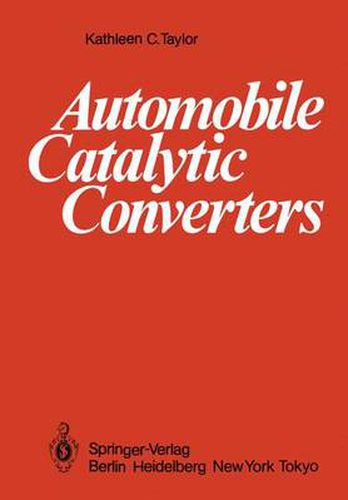Readings Newsletter
Become a Readings Member to make your shopping experience even easier.
Sign in or sign up for free!
You’re not far away from qualifying for FREE standard shipping within Australia
You’ve qualified for FREE standard shipping within Australia
The cart is loading…






This title is printed to order. This book may have been self-published. If so, we cannot guarantee the quality of the content. In the main most books will have gone through the editing process however some may not. We therefore suggest that you be aware of this before ordering this book. If in doubt check either the author or publisher’s details as we are unable to accept any returns unless they are faulty. Please contact us if you have any questions.
The use of catalytic converters for the purification of automotive exhaust gases is a relatively new technology which was brought into existence by social pressures for the preservation of acceptable environmental conditions. The majority of catalytic practitioners have been able to watch the growth of this technology from its inception to its current state of sophistication. Automotive catalytic converter technology is now in a mature state, and this chapter from Vol. 5 Catalysis: Science and Technology by Dr. K. C. Taylor provides a review which covers both the process chemistry and the most important converter design factors. Contents 1. Introduction… … … … . . 2. Emission Regulations in the United States. 3. Exhaust Emission Characteristics. . 3 4. 1981 Emission Control Technology. 5 A. Converters… 5 B. Control System. 7 8 ~. Catalyst Screening . 6. Laboratory Testing. .10 7. The Chemical Reactions 13 8. Composition of Three-Way Catalysts. 16 A. Rhodium 17 21 B. Platinum. C. Palladium 22 D. Iridium . 22 23 E. Ruthenium and Nickel. F. Cerium Oxide ….. 23 G. Search for Alternatives to Nohle Metals 24 9. Catalyst Supports . 25 A. Pellets …. 26 B. Monoliths . . 26 10. The Transient Behavior of Three-Way Catalysts 27 II. Deterioration of Three-Way Catalysts. 35 A. Thermal Effects… . 35 B. Phosphorus Poisoning… 37 C. Lead Poisoning… … * 38 D. Catalyst Poisoning by Sulfur * 40 12. The 0.4 NO,; Research Objective. * 41 13. Control of Diesel Particulate Emissions.
$9.00 standard shipping within Australia
FREE standard shipping within Australia for orders over $100.00
Express & International shipping calculated at checkout
This title is printed to order. This book may have been self-published. If so, we cannot guarantee the quality of the content. In the main most books will have gone through the editing process however some may not. We therefore suggest that you be aware of this before ordering this book. If in doubt check either the author or publisher’s details as we are unable to accept any returns unless they are faulty. Please contact us if you have any questions.
The use of catalytic converters for the purification of automotive exhaust gases is a relatively new technology which was brought into existence by social pressures for the preservation of acceptable environmental conditions. The majority of catalytic practitioners have been able to watch the growth of this technology from its inception to its current state of sophistication. Automotive catalytic converter technology is now in a mature state, and this chapter from Vol. 5 Catalysis: Science and Technology by Dr. K. C. Taylor provides a review which covers both the process chemistry and the most important converter design factors. Contents 1. Introduction… … … … . . 2. Emission Regulations in the United States. 3. Exhaust Emission Characteristics. . 3 4. 1981 Emission Control Technology. 5 A. Converters… 5 B. Control System. 7 8 ~. Catalyst Screening . 6. Laboratory Testing. .10 7. The Chemical Reactions 13 8. Composition of Three-Way Catalysts. 16 A. Rhodium 17 21 B. Platinum. C. Palladium 22 D. Iridium . 22 23 E. Ruthenium and Nickel. F. Cerium Oxide ….. 23 G. Search for Alternatives to Nohle Metals 24 9. Catalyst Supports . 25 A. Pellets …. 26 B. Monoliths . . 26 10. The Transient Behavior of Three-Way Catalysts 27 II. Deterioration of Three-Way Catalysts. 35 A. Thermal Effects… . 35 B. Phosphorus Poisoning… 37 C. Lead Poisoning… … * 38 D. Catalyst Poisoning by Sulfur * 40 12. The 0.4 NO,; Research Objective. * 41 13. Control of Diesel Particulate Emissions.